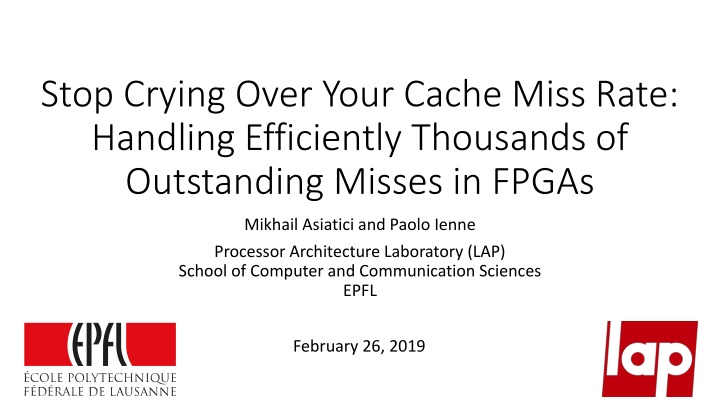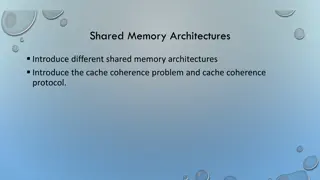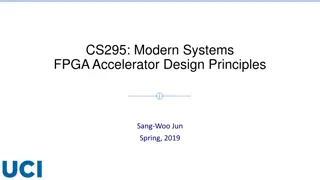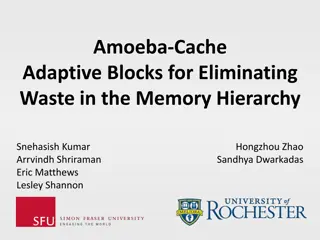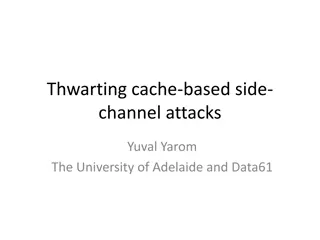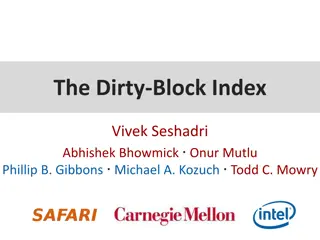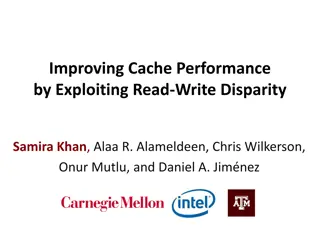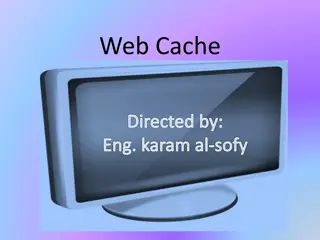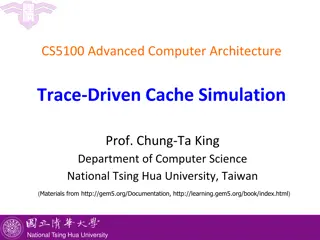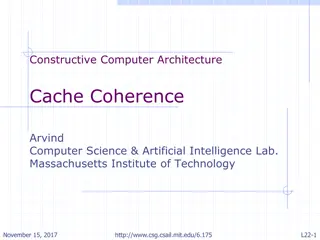Efficient Handling of Cache Miss Rate in FPGAs
This study focuses on improving cache miss rate efficiency in FPGAs through the implementation of non-blocking caches and efficient Miss Status Holding Registers (MSHRs). By tracking more outstanding misses and utilizing memory-level parallelism, this approach proves to be more cost-effective than simply enlarging the cache size. Detailed architecture, experimental setup, and results are discussed.
Download Presentation

Please find below an Image/Link to download the presentation.
The content on the website is provided AS IS for your information and personal use only. It may not be sold, licensed, or shared on other websites without obtaining consent from the author.If you encounter any issues during the download, it is possible that the publisher has removed the file from their server.
You are allowed to download the files provided on this website for personal or commercial use, subject to the condition that they are used lawfully. All files are the property of their respective owners.
The content on the website is provided AS IS for your information and personal use only. It may not be sold, licensed, or shared on other websites without obtaining consent from the author.
E N D
Presentation Transcript
Stop Crying Over Your Cache Miss Rate: Handling Efficiently Thousands of Outstanding Misses in FPGAs Mikhail Asiatici and Paolo Ienne Processor Architecture Laboratory (LAP) School of Computer and Communication Sciences EPFL February 26, 2019
Motivation FPGA Memory 200 MHz 800 MHz DDR Memory-level parallelism Accelerator 32 << 0.8 GB/s DDR3-1600 Memory Memory Controller Blocking Non-Blocking Arbiter Cache Cache 512 12.8 GB/s 64 12.8 GB/s 0.8 GB/s Reuse 32 Accelerator << 0.8 GB/s Data blocks stored in cache, hoping for future reuse 2
Motivation Memory-level parallelism Reuse Non-Blocking Cache If hit rate is low, tracking more outstanding misses can be more cost-effective than enlarging the cache Reuse 3
Outline Background on Non-Blocking Caches Efficient MSHR and Subentry Storage Detailed Architecture Experimental Setup Results Conclusions 4
Non-Blocking Caches MSHR = Miss Status Holding Register Cache array 0x1004 0x100C tag data MSHR array tag subentries 0x100 4 0x123 0xCA8 0x100 0x36C2156B751D4EBB940316495CB 0x1F2D5D08706718799CD58F2F566 0xE9C0F7A7697CBA7CDC1A7934E34 C miss 0x156B 0xEBB9 0x100 0x100: 0x36C2156B751D4EBB940316495CB Primary miss allocate MSHR allocate subentry send memory request Secondary miss allocate subentry MSHRs provide reuse without having to store the cache line same result, smaller area More MSHRs can be better than a larger cache External memory 5
Outline Background on Non-Blocking Caches Efficient MSHR and Subentry Storage Detailed Architecture Experimental Setup Results Conclusions 6
How To Implement 1000s of MSHRs? MSHR array tag subentries One MSHR tracks one in-flight cache line MSHR tags need to be looked up On a miss: primary or secondary miss? On a response: retrieve subentries Traditionally: MSHRs are searched fullyassociatively [1, 2] Scales poorly, especially on FPGAs Set-associative structure? = = = = = = = = [1] David Kroft Lockup-free instruction fetch/prefetch cache organization ISCA 1981 [2] K. I. Farkas and N. P. Jouppi Complexity/Performance Tradeoffs with Non-blocking Loads ISCA 1994 7
Storing MSHRs in a Set-Associative Structure 0x242 Use abundant BRAM efficiently 0x46 0x59 0x10 0x87 8
Storing MSHRs in a Set-Associative Structure 0xA34 Use abundant BRAM efficiently Collisions? Stall until deallocation of colliding entry Low load factor (25% avg, 40% peak with 4 ways) 0x46 0x24 0x59 0x10 0x87 Solution: cuckoo hashing 9
Cuckoo Hashing 0x244 0x591 0x463 0x463 Use abundant BRAM efficiently Collisions can often be resolved immediately With a queue [3], during idle cycles High load factor 3 hash tables: > 80% average 4 hash tables : > 90% average h0 hd-1 0x463 0x100 0x879 [3] A. Kirsch and M. Mitzenmacher Using a queue to de-amortize cuckoo hashing in hardware AACCCC 2007 10
Efficient Subentry Storage subentries tag 4 C 0x100 One subentry tracks one outstanding miss Traditionally: fixed number of subentry slots per MSHR Stall when an MSHR runs out of subentries [2] Difficult tradeoff between load factor and stall probability Decoupled MSHR and subentry storage Both in BRAM Subentry slots are allocated in chunks (rows) Each MSHR initially gets one row of subentry slots MSHRs that need more subentries get additional rows, stored as linked lists Higher utilization and fewer stalls than static allocation tag subentries [2] K. I. Farkas and N. P. Jouppi Complexity/Performance Tradeoffs with Non-blocking Loads ISCA 1994 11
Outline Background on Non-Blocking Caches Efficient MSHR and Subentry Storage Detailed Architecture Experimental Setup Results Conclusions 12
MSHR-Rich Memory System General Architecture subentries tag Nb Ni 13
Miss Handling ID Address 56 0x7362 miss 14
Miss Handling Pointer to first row of subentries 56 0x732 0x736 51 15
tag ptr ID ID ptr Subentry Buffer 0x736 51 56 2 offset 25 3 offset ID Offset Head row from MSHR buffer 51 56 2 rdaddr Subentry buffer wraddr wrdata One read, one write per request: insertion pipelined without stall (dual-port BRAM) rddata 51 25 3 Free row queue (FRQ) Update logic Response generator 25 3 56 2 16
tag 0x736 ptr ID ID ptr ID ID ptr Subentry Buffer 51 56 2 offset 25 3 offset 103 13 0 offset offset 51 13 0 rdaddr Subentry buffer wraddr wrdata Stall needed to insert extra row rddata 51 25 3 56 2 Free row queue (FRQ) Update logic Response generator 103 103 56 2 25 3 13 0 103 17 103
tag 0x736 ptr ID ID ptr ID ID ptr Subentry Buffer 51 56 2 offset 25 3 offset 103 13 0 offset offset Last row cache 51 A9 2 rdaddr Linked list traversal: stall only sometimes, thanks to last row cache Subentry buffer wraddr wrdata rddata 56 2 25 3 13 0 103 103 Free row queue (FRQ) Update logic Response generator 18
tag 0x736 ptr ID ID ptr ID ID ptr Subentry Buffer 51 56 2 offset 25 3 offset 103 13 0 offset offset Last row cache 51 Data from memory 1AF6 60B3 2834 C57D 2834 C57D rdaddr Subentry buffer wraddr wrdata rddata 51 25 3 25 56 2 56 103 103 Free row queue (FRQ) Update logic Response generator 19
ID ID ptr Subentry Buffer 13 0 offset offset Last row cache 103 1AF6 60B3 2834 C57D 2834 C57D Stall requests only when allocating new row iterating through linked list, unless last row cache hits a response returns rdaddr Subentry buffer wraddr wrdata rddata 13 0 Overhead is usually negligible Free row queue (FRQ) Update logic Response generator 20
Outline Background on Non-Blocking Caches Efficient MSHR and Subentry Storage Detailed Architecture Experimental Setup Results Conclusions 21
Experimental Setup Memory controller written in Chisel 3 4 accelerators, 4 banks Vivado 2017.4 ZC706 board XC7Z045 Zynq-7000 FPGA with 437k FFs, 219k LUTs, 1090 18kib BRAMs (2.39 MB of on-chip memory) 1 GB of DDR3 on processing system (PS) side 3.5 GB/s max bandwidth 1 GB of DDR3 on programmable logic (PL) side 12.0 GB/s max bandwidth f = 200 MHz To be able to fully utilize DDR3 bandwidth 22
Compressed Sparse Row SpMV Accelerators This work is not about optimized SpMV! We aim for a generic architectural solution Why SpMV? Representative of latency-tolerant, bandwidth-bound applications with various degrees of locality Important kernel in many applications [5] Several sparse graph algorithms can be mapped to it [6] [5] A. Ashari et al. Fast Sparse Matrix-Vector Multiplication on GPUs for graph applications SC 2014 [6] J. Kepner and J. Gilbert Graph Algorithms in the Language of Linear Algebra SIAM 2011 23
Higher poorer temporal locality matrix Benchmark Matrices non-zero elements rows vector size stack distance percentiles 75% 90% 95% dblp-2010 1.62M 326k 1.24 MB 2 348 4.68k pds-80 928k 129k 1.66 MB 26.3k 26.6k 26.6k amazon-2008 5.16M 735k 2.81 MB 6 6.63k 19.3k > total BRAM size flickr 9.84M 821k 3.13 MB 3.29k 8.26k 14.5k eu-2005 19.2M 863k 3.29 MB 5 26 69 webbase_1M 3.10M 1.00M 3.81 MB 2 19 323 rail4284 11.3M 4.28k 4.18 MB 0 13.3k 35.4k youtube 5.97M 1.13M 4.33 MB 5.8k 20.6k 32.6k in-2004 16.9M 1.38M 5.28 MB 0 4 11 ljournal 79.0M 5.36M 20.5 MB 19.3k 120k 184k mawi1234 38.0M 18.6M 70.8 MB 20.9k 176k 609k road_usa 57.7M 23.9M 91.4 MB 31 601 158k https://sparse.tamu.edu/ 24
Outline Background on Non-Blocking Caches Efficient MSHR and Subentry Storage Detailed Architecture Experimental Setup Results Conclusions 25
Area Fixed Infrastructure Baseline: cache with 16 associative MSHRs + 8 subentries per bank Blocking cache & no cache perform significantly worse MSHR-rich: -10% slices MSHRs & subentries: FFs BRAM < 1 % variation depending on MSHRs and subentries Slices Baseline with 4 banks 11.0k Our system with 4 banks 10.0k (4 accelerators + MIG: 11.9k) What about BRAMs? 26
BRAMs vs Runtime Area (BRAMs) Runtime (cycles/multiply-accumulate) 27
BRAMs vs Runtime 6% faster, 2x fewer BRAMs 3% faster, 3.4x fewer BRAMs 1% faster, 3.2x fewer BRAMs 6% faster, 2x fewer BRAMs Same performance, 5.5x fewer BRAMs 90% of Pareto-optimal points are MSHR-rich 25% are MSHR-rich with no cache! 7% faster, 2x fewer BRAMs 25% faster, 24x fewer BRAMs Same performance, 3.9x fewer BRAMs 6% faster, 2.4x fewer BRAMs 32
Outline Background on Non-Blocking Caches Efficient MSHR and Subentry Storage Detailed Architecture Experimental Setup Results Conclusions 33
Conclusions Traditionally: avoid irregular external memory accesses, whatever it takes Increase local buffering area/power Application-specific data reorganization/algorithmic transformations design effort Latency-insensitive and bandwidth-bound? Repurpose some local buffering to better miss handling! Most Pareto-optimal points are MSHR-rich, across all benchmarks Generic and fully dynamic solution: no design effort required 34
Thank you! https://github.com/m-asiatici/MSHR-rich 35
Backup 36
Benefits of Cuckoo Hashing Achievable MSHR buffer load factor with uniformly distributed benchmark, 3x4096 subentry slots, 2048 MSHRs or closest possible value 37
Benefits of Subentry Linked Lists Subentry slots utilization External memory requests Subentry-related stall cycles All data refers to ljournal with 3x512 MSHRs/bank 38
Irregular, Data-Dependent Access Patterns: Can We Do Something About Them? Case study: SpMV with pds-80 from SuiteSparse [1] Assume matrix and vector values are 32-bit scalars 928k NZ elements 129k rows, 435k columns 1.66 MB of memory accessed irregularly Spatial locality: histogram of reuses of 512-bit blocks pds-80 as it is has essentially same reuse opportunities as if it was scanned sequentially but, hit rate with a 256 kB, 4-way associative cache is only 66%! Why?? 39 [1] https://sparse.tamu.edu/
Reuse with Blocking Cache Four cache lines, LRU, fully-associative: M M M time +1 cache line: M M time Eviction limits reuse window Mitigated by adding cache lines Longer memory latency more wasted cycles 40
Reuse with Non-Blocking Cache Four cache lines, LRU, fully-associative: M M M time Four cache lines, LRU, fully-associative, one MSHRs: M M M M time MSHRs widen reuse window Fewer stalls, wasted cycles less sensitive to memory latency In terms of reuse, if memory has long latency, or if it can t keep up with requests, 1 MSHR 1 more cache line 1 cache line = 100s of bits 1 MSHR = 10s of bits Adding MSHRs can be more cost-effective than enlarging the cache, if hit rate is low 41
Stack Distance Stack distance: #different blocks referenced between to references to the same block {746, 1947, 293, 5130, 293, 746} S = 1 S = 3 Temporal locality: cumulative histogram of stack distances of reuses Fully associative, LRU cache Realistic cache Always a hit Can be a hit 4,096 (256 kB cache) 42
Harnessing Locality With High Stack Distance Cost of shifting the boundary by one: one cache line (512 bit) Is there any cheaper way to obtain data reuse, in a general case? Can be a hit 4,096 (256 kB cache) 43
MSHR Buffer Request pipeline must be stalled only when: Stash is full A response returns Higher reuse fewer stalls due to responses 44
